Exhibition Reviews
| Home | | Museum Guide | | International | | Theater |
Leonardo Goes To Milwaukee
The Splendor of Poland: A History of Collecting and Patronage
By Edward Rubin
It used to be, other than a few comments here and there, one rarely if ever
heard the words Milwaukee and Art mentioned in the same breath. Beer, yes.
Art, no. Well, that was yesterday. Today, everything has changed and radically
so. With the Milwaukee Art Museum's spectacular new spaceage Quadracci Pavilion,
designed by Santiago Calatrava, coupled with an amazing and perfectly bejeweled
refurbishing of its two, long depressing and dimly lit older buildings, the
museum has lifted itself one step closer to Art Heaven.
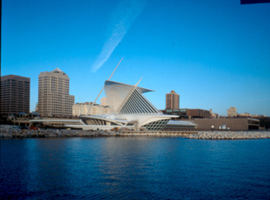 |
| Milwaukee Art Museum. Photo: Timothy Hursley. |
With 30% more exhibition space, spectacular lighting, and a soaring, 90-foot high glass-enclosed atrium that looks out onto Lake Michigan just inside the museum's entrance, you get the distinct feeling that you are entering into another world. Now, for the first time in a long time, people across the country are talking about Milwaukee and Art. In fact they won't shut up. Of course, with a 122 million dollars, which is somewhere in the neighborhood of what this total makeover cost, you too could be a beauty with a reputation
Capitalizing on its newly acquired celebrity, the Milwaukee Art Museum, long perceived as an offshoot of the Chicago artworld, is obviously intent on becoming an institution of international importance in its own right. To this end the museum has been pulling out all the stops. With Russell Bowman, its long time director out and David Gordon, its new director coming straight from London's Royal Academy of Arts to take the helm, it appears that the Milwaukee Art Museum will be going in a totally new direction.
Dare I talk blockbusters?
The museum's current exhibition, Leonardo Da Vinci and the Splendor of Poland, A History of Collecting and Patronage the brainchild of Laurie Winters, the curator of Earlier European Art is a shrewd move on all fronts. On the local level, it is the perfect going away gift to the city of Milwaukee, from Russell Bowman who sanctioned the exhibition by giving Winters free reign to her imagination. It is also a gift, not to mention a smart political move, to the three and one half million people of Polish heritage that live in and around Milwaukee and Chicago.
Last but not least, the exhibition with its 77 paintings imported from Poland, many of which have never been never been seen in this country before, is a show of both national and international importance. For the country of Poland and the museum, it is a major step onto the international artworld stage. Once the 'The Splendor of Poland' leaves Milwaukee on November 24, it will be traveling to The Museum of Fine Arts in Houston (December 8, 2002-February 16, 2003) and to the Fine Arts Museums of San Francisco California Palace of the Legion of Honor (March 8-May 18, 2003).
The history of the entire exhibition, from curator Laurie Winters' initial fixation on Da Vinci's The Lady with an Ermine to the transporting of both people and the art across the ocean, has all of the trappings of a James Bond Movie. The cost to insure the exhibition must have been staggering. Its two stars alone, pampered to the nth degree, probably broke the bank. Memling's The Last Judgment, was escorted to the US by couriers from the Wawel Royal Castle and The National Museum in Warsaw. The painting was greeted and inspected on UD soil by Poland's most important conservator, Bogumila Rouba, as well as the Director of the National Museum in Gdansk, and a curator from the same - a true entourage. 'The Lady', as true ladies are wont to do, demanded and got star treatment. She too was personally escorted by curator Winters and Januz Walek and Anne Grochowska-Angelus, respectively the director and conservator of the Princes Czartoryski Museum in Cracow. As befitting a national treasure, the paintings traveled first class on LOT Polish Airlines in a crated container that is climate-controlled with a built-in security system. Both paintings had a military escort in Poland and a police escort in the US.
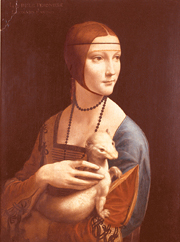 |
| Leonardo da Vinci, Lady with an Ermine (Portrait of Cecilia Gallerani), ca. 1490. Oil and tempera on panel. The Princes Czartoryski Museum, Cracow. |
The draw of show, certainly as far as the curator, press and public is concerned
- his name alone guarantees that attention will be paid - is Leonardo Da Vinci's
painting, Lady with an Ermine (CA. 1490). The English critic Sir John Pope
Hennessy called 'The Lady' the first painting in European art to introduce
the idea that a portrait may express the sitter's thoughts through posture
and gestures, an idea entertained by Leonardo himself. Like the Mona Lisa,
one of only four existing Da Vinci's female portraits, the painting, apart
from the wonderful rendering of the exotic ermine - never badmouth an ermine
- at best is as exciting as a rare postage stamp. Philatelists take note!
Of course, all is in the eye of the beholder. I have a similar problem, on
a far lesser scale, with Vermeer too. Still, we mustn't dismiss this lady
too soon, for curiously enough, it is this one small painting, long obsessed
over by Ms. Winters, to which we owe this entire stellar exhibition. Little
did the curator know that in asking for the Lady with an Ermine the entire
country of Poland would come riding in on its coattails, a perfect example
of asking for a hand and getting two arms, two legs and an entire body of
spectacular works.
Of the exhibition's 77 paintings, which span 363 years (1540-1903), nearly
a third are by Polish artists. The rest, with only one entry each from Sweden,
England and Spain, are more or less equally divided amongst the Dutch, Italian,
Flemish, French and German painters, those painters which were most popular
with early Polish collectors. I might add, all are generously spaced and radiantly
lit. One of the more commanding paintings on view - and one could spend an
entire lifetime studying this triptych - is Hans Memling's, The Last Judgment
(1467-71). Originally painted as an altarpiece, it depicts the moment of transition
from earthly time to eternity, from Heaven to Hell. The painter's intent was
to inspire the faithful with fear of eternal damnation, and to invoke deep
religious reflection and contemplation. His vision of the "eighth day"
- that is, the depiction of the end of time - combines a number of medieval
iconographic motifs such as Christ enthroned on the rainbow, the resurrection
of souls and Archangel Michael rescuing the faithful.
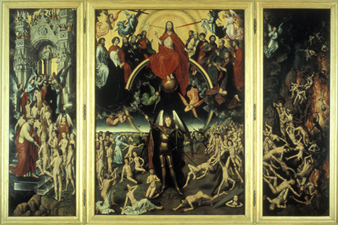 |
| Hans Memling, The Last Judgment, 1467-71. Tempera and oil on oak panel., Gdansk, The National Museum. |
Like Poland itself, The Last Judgment, comes with a turbulent history attached.
Painted in Belgium, very early in Memling's career, the painting en route
to the Netherlands, destined for the church of Badia Fiesolana - specifically
for the family chapel of the banker of the Medicis in Florence - was hijacked
by a pirate in 1473 and presented to the church of St. Mary's in Gdansk. Despite
protests and complaints of the Duke of Burgundy, Charles the Bold, and Pope
Sixtus IV, the work remained in Gdansk until 1807 when Napoleon confiscated
it for his museum in Paris. With the downfall of Napoleon, the Prussians took
the painting to Berlin. Eventually, after much protest it was returned to
Gdansk in 1816 only to have it removed by the Germans during World War II.
Found by the red army, after the Germans were defeated, it was taken to the
Hermitage Museum in Leningrad only to be eventually returned to Gdansk in
1956, where it now resides at The National Museum.
Particularly stunning are the four Warsaw cityscapes of Italian painter Bernardo
Bellotto (1721-1780). Trained as a painter of cityscapes, Bellotto, already
famous for his splendid images of many of the greatest cities of Europe, arrived
in Warsaw in 1767 where he was quickly appointed court painter by the last
king of Poland, Stanislaus II Augustus Poniatowski. Here he spent the final
twelve years of his life. His most important work of this period, to which
these four paintings belong, is a series of twenty-six views of Warsaw, intended
for a particular suite, the so-called "Canaletto Room," in The Royal
Castle. (Belletto often signed his paintings with his given name and surname,
as well as the nickname "Il Canaletto," no doubt to draw attention
to his relationship with his celebrated uncle).
The Warsaw series focuses on the early eighteenth-century city; that is, Baroque Warsaw. The palaces of the magnates and the churches are the motifs Bellotto selects as his principal subjects in his views of the center of the city. Other Warsaw views depict urban landscapes, along with views of gardens, streets and square. The artist's ability to capture the light and the life of the places he depicted was unparalleled. His panoramic Warsaw views, the visual equivalent of Balzac's, La Comedie Humaine, are animated by a powerful response to the inhabitants of the city and its environs; the realistic treatment of the figures, anticipating the genre quality so pronounced in nineteenth-century paintings of the urban scene. One scholar noted nearly 3,000 human figures in Bellotto's views of the center of Warsaw, half of which can be assigned to a specific professional and social standing by their appearances and dress.
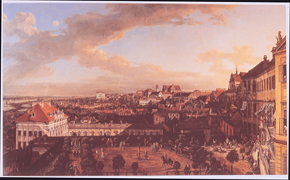 |
| Bernardo Bellotto, View of Warsaw from the Terrace of the Royal Castle,, 1773. Oil on canvas. Warsaw, The National Museum. |
So accurately did Bellotto record the city's architectural facts, that his Warsaw paintings were used as models for the reconstruction of individual buildings and whole quarters of the city following the Second World War. Again, like the history of much of Poland's art treasures, these paintings found themselves in Paris by order of Napoleon, in Russia by order of Tsar Nicholas I and in Germany thanks to the Nazis. They are currently back hanging at their original home, the totally reconstructed, Royal Castle in Warsaw.
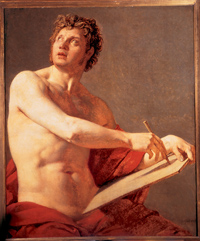 |
| Jean-Auguste-Dominique Ingres, French,1780 -1867, Academic Figure, 1801,oil on canvas, 38 3 /8 x 31 3 /4 in,97.5 x 80.6 cm, Warsaw,The National Museum. |
Though the paintings of Da Vinci, Memling and Bellotto are the crème
de la crème of the exhibition, and they certainly do supply much of
the pomp and circumstance, the exhibition also includes a large number of
beautifully painted, one could almost say masterpieces, and many unusual and
most welcome surprises. One of the more startling inclusions is an early painting
by Jean-Auguste-Dominique Ingres (1780-1867) titled Academic Figure (1801).
Executed while the young Ingres was still working in the studio of Jacques-Louis
David, this semi-nude male is as fresh and alive as the day it was painted.
Painted in accordance with the principles of execution of an academie - an
oil sketch of a human figure - as practiced at the Ecole des Beaux-Arts, this
composition remains unfinished in several areas, thereby intentionally showing
the various phases of the artist's work. Academic Figure was so perfectly
rendered by Ingres, that it served for several years as an instructional model
for students at the Ecole du Dessin at Montauban, where Ingres' father was
a professor.
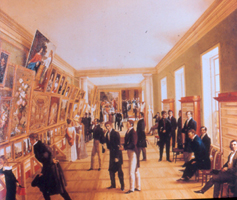 |
| Wincenty Kasprzycki, Polish,1802 -1849, Exhibition of Fine Arts in Warsaw, 1828,oil on canvas, 37 1 /4 x 43 3 /4 in,94.5 x 111 cm, Warsaw,The National Museum. |
With a penchant for historical documentation, Wincentry Kasprzycki's (1802-1849)
Exhibition of Fine Arts in Warsaw (1828) shows the mineral collection room
of the University of Warsaw adapted for the annual Exhibition of Fine Arts.
Here the painter presents an accurate recording of the room and the exhibition,
as well as portraits of artists and the public. Many of the artists and their
works are identifiable. The painting remains the only visual record of one
of the nine public art exhibitions held in Warsaw during the first half of
the nineteenth century, during the Biedermeier period. As the picture depicts,
the exhibition hung in three tiers on specially designed scaffolding that
covered the wall facing the windows. Works in the exhibition were displayed
according to their formats, although some attempt was made to group them by
pictorial genre. Speaking of Biedermeier, Winters, much the young 'revisionist'
historian, is already knee deep in planning an all inclusive, painting, furnishings
and whatnot, Biedermeier Exhibition. Like The Splendor of Poland, this ambitious
undertaking promises to be another groundbreaker.
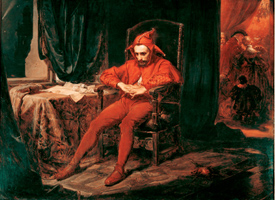 |
| Jan Matejko, Polish,1838 -1893, Stanczyk,the King 's Jester, 1862,oil on canvas, 34 5 /8 x 47 1 /4 in,88x 120 cm, Warsaw,The National Museum. |
Another painting that bears careful study is Jan Matejko's (1838-1893) Stanczyk, The Kings Jester (1862). Famous for his biting wit and brilliant mind, Stanczyk (ca. 1480-1560) court jester to successive Jagiellonian kings of Poland became known as a national symbol of patriotism and civic conscience. In this painting the jester, all in red, sits alone in the semidarkness of a room in Wawel Castle. His caduceus - symbol of his role as clown - lies cast aside on the floor. On the table a sheet of paper with the news of the loss of Smolensk relates the cause of his sorrowful meditation on the fate of his country. Behind the door a joyful ball is in progress, while he alone foresees the calamitous aftermath of the loss of the important borderland stronghold in battle. Stanczyk's tragic forebodings find symbolic confirmation in the falling comet discernible in the sky next to the cathedral bbtower. Matejko himself is often referred to as the 'pope' of Polish painting.
 |
| Aleksander Gierymski, Polish,1850 -1901, Feast of Trumpets, 1884,oil on canvas, 18 1 /2 x 25 3 /8 in,47 x 64.5 cm, Warsaw,The National Museum. |
One of the most beautiful paintings in the exhibition, again a historical recording, this time of the Jewish population in Poland, is Alexsander Gierymski's (1850-1901) Feast of Trumpets (1884). Feast of Trumpets belongs to a series of works depicting everyday life in the poorest sections of Warsaw. Here the artist presents the ritual of washing away sins for the Jewish high holiday Rosh Hashanah, connected with the atonement for the new year (in Poland popularly called the trumpet holiday in reference to the sounding of the ram's horn, the shofar). The concentration of the praying men is echoed in the stillness of nature at nightfall. The elegiac, pensive mood is heightened by the light of the waning day - golden sunbeams reflected in the mirror of the water emphasizes the painting's subtle modulation of light and color. The rhythmic vertical accents of the masts of the boats and the slender figures against a flat expanse of river and sandy bank establish an almost musical harmony enhanced by the magnificent luminosity of colors.
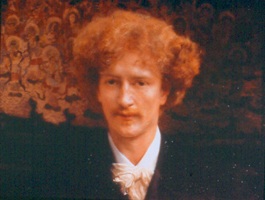 |
| Sir Lawrence Alma-Tadema, English,1836 -1912, Portrait of Ignacy Jan Paderewski, 1891, oil on canvas, 17 7 /8 x 23 1 /4 in,45.5 x 59 cm, Warsaw,The National Museum. |
Another surprise and one of the more 'modern' paintings in the exhibition is a wonderful portrait of the young redheaded Ignacy Jan Paderewski by the Dutch born, Victorian classicist, Sir Lawrence Alma-Tadema (1836-1912). The painting, one of Alma-Tadema's late academic works from the turn of the century that depicts famous musicians of the Victorian and Edwardian periods, presents Paderewski against a background of two colored surfaces: an orange-yellow Japanese textile and the paneling in a uniform, dark olive-green hue. It was painted at the height of the pianist's popularity in 1881. After studying in Antwerp, Cologne, and Brussels, Alma-Tadema settled in 1870 in England, where he established his reputation. Paderewski (1860-1941) was one of Poland's most revered native sons, admired for his brilliant musical career, his humanitarianism, and his political service as Poland's Prime Minister at the conclusion of World War I and as a lifelong champion of Polish independence.
Beautiful paintings aside, The Splendor of Poland exhibition and catalogue is a virtual mini course in the history of Poland. For what do we know about Poland other than the current Pope, the killing of most all of its 3 million Jews during World War 2 (Treblinka and Auschwitz are in Poland) and perhaps Lech Walesa's Solidarity Movement during the eighties. While the exhibition itself, with its occasional wall-posted explanations, does gives us a hint of Poland's tumultuous history, it is the catalogue, geared far more to the academic than to the general public, that goes furthest in remedying our ignorance. Here we are exposed, nay, drowned is a better word, to the past and present history of Poland. Along with its citizens we are subjected to its many partitions and repartitions, centuries of being overrun and decimated, continually, by its neighbors Russia, Prussia, Austria, Germany, Lithuania, Turkey, and Sweden, all of which treated the country and its cultural heritage as spoils of war.
The catalogue, with its countless essays, maps, photos and colored reproductions of all the paintings included in the show - complete with wonderfully detailed histories of the painters and their times - liberally 'annexed' by me for this review- in actuality supplies 327 pages of fact-filled subtext. It appears that through its ten essays - one by the curator and nine by various scholars and museum officials - that no stone has been left unturned. From the country's very beginnings, in the year 966AD, all the way up to the present day - always with one eye on the invading armies and the country's many subsequent governments and the other on the cultural history of Poland - we are transported across the centuries. Special attention is paid to Royal Patronage and the history and the collection of the country's art, unlike other countries, much of which was amassed during times of occupation.
Ironically for the country that had the second constitution in the world (1791) and the first in Europe, for 123 years (1795-1918) Poland - divided among Russia, Prussia and Austria - didn't exist. It was erased from the map. It was only after World War 1, after six generations, that Poland regained its independence and that didn't last long. With the German onslaught of Poland in 1939, which started World War 11 - today, forgotten by almost everybody but the Poles - the country suffered its greatest losses. Despite the Treaties of Versailles and Riga, which guaranteed the existence and borders of the Polish Republic, and the non-aggression pacts that Poland signed with the Soviet Union (1932) and Germany (1934), with the German-Soviet Treaties of 1939, once again Poland was divided ruthlessly between the two totalitarian states.
During the eighteen months of Russian occupation the most active individuals from all walks of life were murdered. Hundreds of thousands of people were arrested and sent to Soviet concentration camps. Together with members of their families, upwards of 1.5 million Poles were imprisoned in the Gulag system. Most of them died of exhaustion and famine. In the spring of 1940, 15,000 Polish officers, who had been taken prisoners of war, were also murdered.
The fate of the Polish citizens under the German occupation was no less horrible. The aim of the Germans was to turn Poles into unskilled laborers. High schools and universities were closed. Mass arrests and executions continued unabated throughout the occupation period. A network of concentration camps using slave labor was established and millions perished. During the entire Nazi occupation of 1939-45, all museums in Poland were closed down. Numerous museum buildings were destroyed and their collections, the Lady with an Ermine among them, were methodically plundered and sent to the Third Reich. Likewise, most private collections were destroyed or confiscated.
After the Warsaw uprising in 1944, Poland's attempt to win full independence, the entire population of Warsaw, nearly one million people, were expelled and the Germans started to destroy what was left. It was here that the Royal Castle that had housed Bellotto's Warsaw Views, after the paintings were spirited away to Germany, was leveled. As a result of Germany's policy of terror - a total of 6 1/2 million, including almost all of Poland's Jews were extinguished. The capital city was annihilated. Material and cultural losses were tremendous. (In late sixties, with the resurfacing of anti-Semitism, most of the remaining Jews emigrated). Out of the one hundred and seventy-five pre-war museums, only twenty-two existed when the war ended. In addition to all of the carnage, Poland emerged from the war with a government imposed from the outside (something of a double cross by Russia, the US and England) and composed of people whom the nation did not trust - changes the Polish people did not want. The next 45 years Poland was to be ruled, under the red banner, by the iron hand of Communism.
In the post-war years, the Department of Museums, under the Communist government, set its sights on the reconstruction of former museums and the reorganization of museum management. The vast majority of surviving museums were nationalized and management, which gave the government total control, was centralized. In the spirit of a Marxist ideology enriched by Leninist and Stalinist theories about nationhood, the management of museums, whether they were qualified museum professionals or not, was given over to politically reliable party officials. Directors of the larger museums, those that were not dismissed, were subject to continual threats of dismissal unless they towed the party line.
Not all was bad. The Department of Museums did institute a restitution campaign to recover the museum collections that had been taken to Germany and Austria. This campaign saw the return of more than one hundred railway cars and several hundred truckloads of art, among them Bellotto's famous views of Warsaw and Da Vinci's Lady with an Ermine. Still later came the return of objects from Polish collections that after the war found their way to the Soviet Union. Whether or not all of the works have been returned from the inaccessible storerooms in Russian Museums remains an open question.
The third and final task of the Department was to "secure objects formerly
belonging to manors," that is, both land and objects of cultural value
that had been seized in connection with the 1944 Agrarian Reform Decree. With
this decree, museums were ordered to take possession of all objects of cultural
value. As a consequence, the contents of museum collections expanded substantially
and the lands, parks, and palaces that had been confiscated were turned into
public parks and museums. A large number of overtly political museums, intended
to disseminate propaganda and commemorate revolutionary movements and their
heroes, such as Lenin, were also established.
Today, under a democratic government, almost 450 museums in Poland have been
turned into independent, self-governing bodies at communal, district and provincial
levels. Only thirteen museums, those that are frequented most by tourists,
remain the most highly supported institutions. For the smaller and less popular
institutions state grants have been reduced to a minimum. Museums, especially
those controlled by the local authorities, are compelled to engage more fully
in all aspects of their communities. As the result of numerous institutional
transformations and new economic and legal regulations the directors are faced
with the necessity of adapting the functioning of their museums to the demand
of a market economy. In many cases this is tantamount to staff reduction,
increased professional qualifications, and - perhaps most difficult - the
need to accept as a museum model an institution responsive to the expectations
of a wider public.
Notwithstanding its post-war restitution campaign, Poland will never be able
to repair the enormous losses suffered by its museums and private collections
during World War II. Along with the destruction of many museums and the plundering
of their collections, it is extremely difficult to establish precisely the
extent of losses sustained. Most inventory books and archives were either
lost or destroyed. Documenting losses in private collections is even more
problematic, and in the majority of cases they had not been inventoried at
all. Attempts to create a complete register of the art losses suffered in
Poland are currently being undertaken by the government. There are also ongoing
efforts among museum officials both in Poland and internationally to recover
works of art that were lost or stolen during World War II.
The greatest threat to the stability of Poland's museums today, according to Andrej Rottermund in his catalogue essay, A History of Impermanence, just may come from numerous claims for the restitution of artworks currently displayed as part of their collections. With the repeal of the Agrarian Reform Act, former owners who were illegally deprived of their collections are already making demands for restitution. Churches that had their works transferred to museums and the heirs of families that placed their works for safekeeping in both banks and museums during World War II only to have them confiscated by the Nazis, the Russians and Poland's Communist government are also seen as threat to the museums. Indeed, even a painting destined for this current exhibition had to be pulled last minute. It was feared it would be seized enroute or at the museum itself and caught up in a lengthy court case.
One might ask, in light of the above complexities, what is the current policy of museums in Poland? Nimbly straddling the line of political correctness Wojciech W. Kowalski, former Government of Poland Commissioner for Cultural Property Abroad (1991-94) both raises and answers this question. "On the one hand they (museums) are obligated to respect the right of ownership, while on the other hand they must do their best to retain the most important objects within the public domain. Consequently, museums are resolved to make restitution of the objects owned by particular persons, provided that the ownership has been established beyond any doubt. While guided by this principal they must seek, nevertheless, to keep the centerpieces of their collections. " What is most amazing is that the Polish people, in the face of a geopolitical order that shattered its national independence throughout much of the 19th and 20th century, has managed hang on to its cultural identity. In no small way, this exhibition is a testament to its resilience.
Edward Rubin is a writer and critic living in New York City. His articles and reviews have appeared in ARTnews, New Art Examiner, www.manhattanarts.com, Hispanic Outlook, www.nytheatre-wire.com and Theatre Week. He can be reached at erubin5000@aol.com.